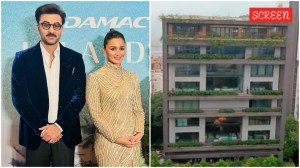Time machine
A Kangaroo boxing with a man in a hat, a runaway coffin chased by motley crew of mourners, a Faustian encounter with the devil and a group of dancing skeletons that chase Jack down the beanstalk—these quaint black-and-white images parade across the plasma television screen...

Seminal archival films from the ’20s and ’30s trace the origins of avant-garde cinema
A Kangaroo boxing with a man in a hat, a runaway coffin chased by motley crew of mourners, a Faustian encounter with the devil and a group of dancing skeletons that chase Jack down the beanstalk—these quaint black-and-white images parade across the plasma television screen, replete with scratches and jumps. A unique blend of archival cinema displayed on technologically advanced equipment is a result of the coming together of two people: gallery owner Farah Siddiqui and writer-curator Lucian Harris, a British Delhi-based art historian.
The exhibition titled, A Repository of Dreams: An Installation of Early Avant-garde Films, is an effort to reach out to art students, enthusiasts and collectors who are willing to go beyond the buying and selling of art.
“The Dadaist and Surrealist movements have had a very big impact on art and cinema and many artists have been influenced by it. I toyed with the idea of curating a package of seminal films, by artists like Man Ray and Rene Clair, Salvador Dali, Francis Picabia and, of course, Marcel Duchamp. It came together when Farah offered her space,” says Harris.
“In London at the Tate or in New York at MOMA, it isn’t a big deal to have access to these kinds of archival films. But in India there is a dearth of spaces to show something like this, since most art is driven by commerce,” adds Harris, also rather critical of the over-pricing of art. “The mission of a space like FSCA (her gallery, Farah Siddiqui Contemporary Art) is to balance the commercial with that which is experimental,” says Siddiqui.
Harris explains that artists like Duchamp and Hans Richter embraced the new and exciting medium of short film not only for its aesthetic appeal but as a symbolic expression of the age of mechanical reproduction.
Some American films turned their lenses towards the great explosion of industry and architecture. Contemporaries and experimental filmmakers like Robert Florey, Paul Strand and Charles Sheeler focused on the skyscrapers and flickering city lights forming a huge futuristic canvas for their abstract and surreal filmic visions.
Charles Sheeler and photographer Paul Strand’s Manhatta(n) is the first significant title in the history of American avant-garde cinema. It is a seven-minute portrait of New York City and focuses on those features which make the city a megalopolis.
“These seminal hallucinatory experiments and quasi documentaries are crucial celluloid documents of the 20th century avant-garde that, nearly 100 years later, continue to inform today’s contemporary art and cinema,” says Harris who looped the films, put in bits of introductory text, music and assembled groups of filmmakers according to artistic sensibilities and country.
“Having exposure to cinema like this is a rare treat. Film clubs usually focus on more contemporary short-films. By creating a dialogue around early cinema, we hope to reach out,” concludes Siddiqui.





- 01
- 02
- 03
- 04
- 05


























